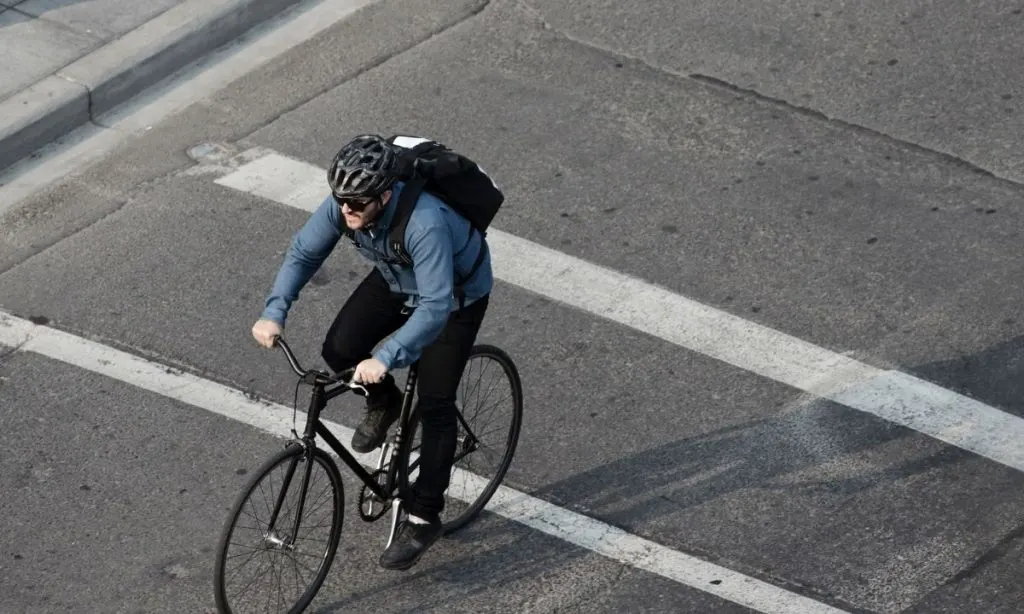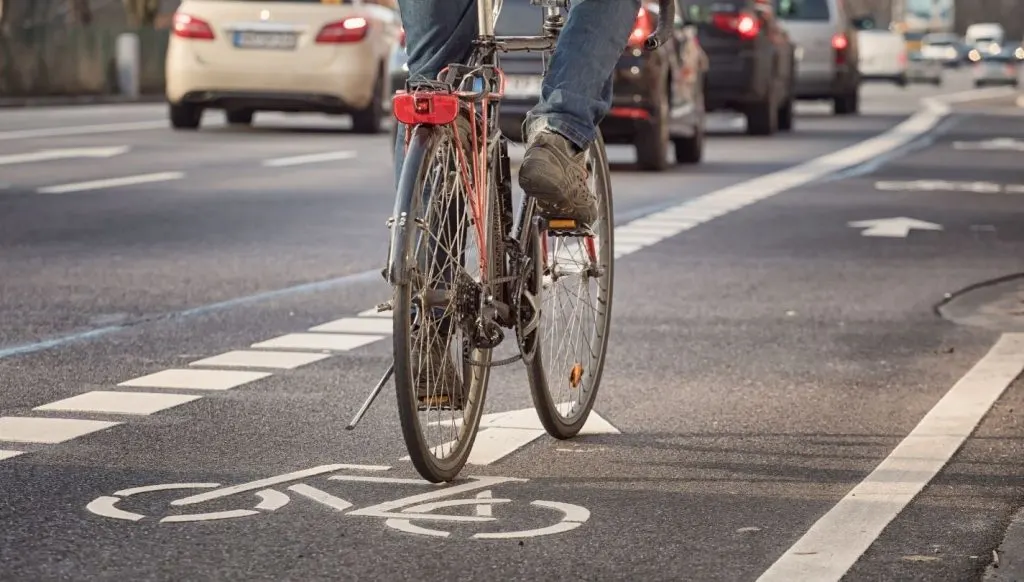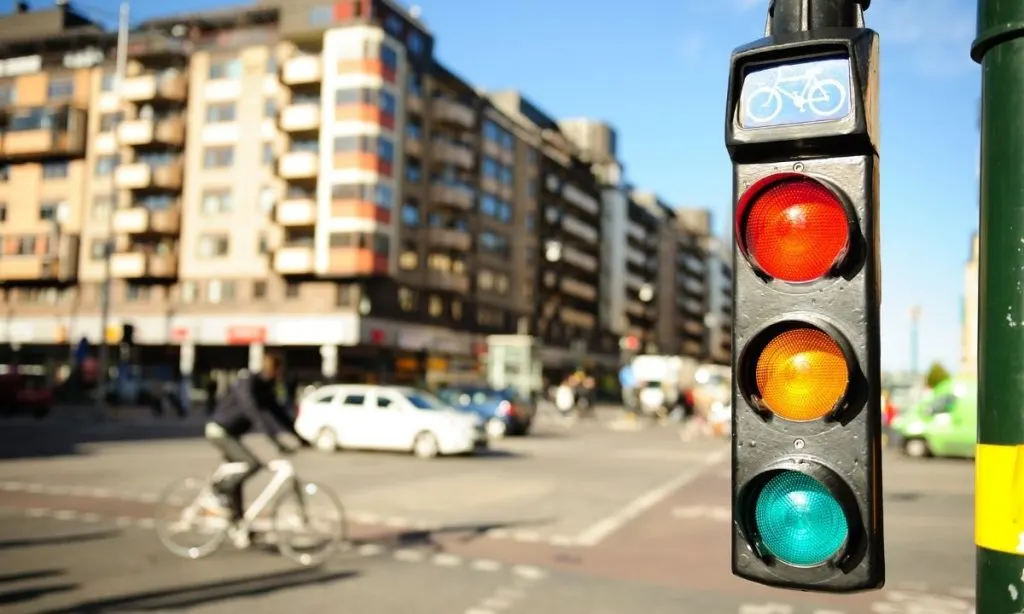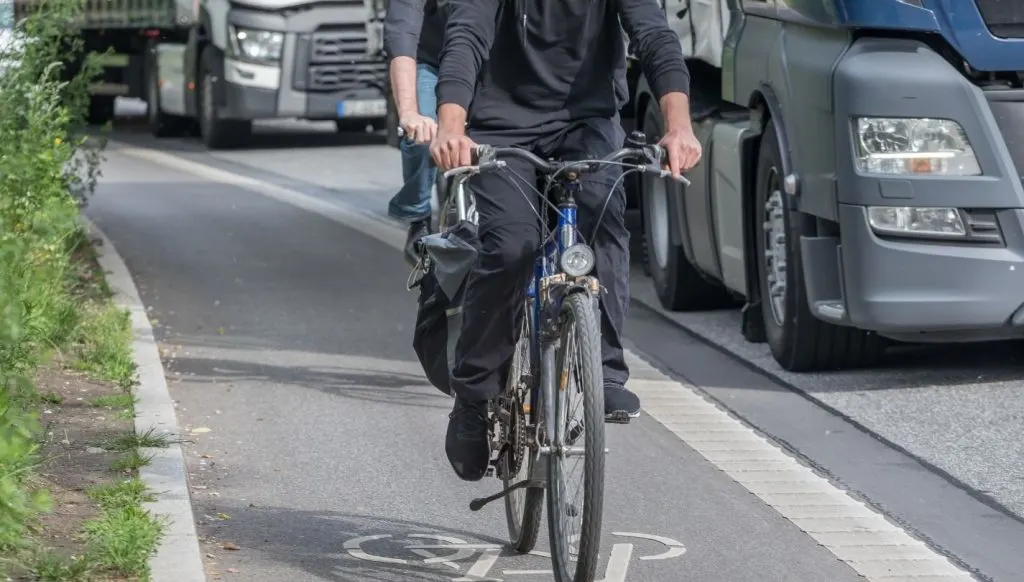
The transition between biking casually (or little) to using it as your mode of transportation in the city is a big leap – even if you live in a small town. There are new things that you need to pay attention to and rules that you need to abide by when riding your bike into town.
Things to remember when riding a bike in town include:
- Getting used to biking
- Making sure your bike is in good riding condition
- Finding a cycle buddy
- Planning out your route
- Being conscious of space
- Knowing and following the rules of the road
- Using hand signals
- Being highly visible at all times
- And more!
Despite the number of things to remember when riding a bike into town, cycling isn’t dangerous. So long as you are practicing safe cycling, then you are more than equipped. Below I’ve listed off many things you need to remember in order to cycle safely while around town.
1. Practice Cycling
Cycling in recent years has grown in popularity and with it comes the realization that it may have been years since you’ve been on a bike. While you can easily tap into your childhood memories to re-teach you how to bike, it’s a whole other story when you are biking in the city.
As a kid, you probably didn’t have to deal with constant moving vehicles around you after all.
In light of this, a good idea is to practice cycling in those areas where you biked as a kid. Places like quiet side streets, a park, or your driveway. Things you want to be able to feel comfortable doing are things like:
- Riding with one hand on the handle
- Checking over your shoulder
- Stopping quickly
- Standing up to pedal
Even if the usual route you’ll be planning out has minimal traffic, being able to do these will help you in the event you’ll need to use them more. Having the confidence to use these techniques can allow you to use biking as a mode of transportation to get to all kinds of other places.
2. Checking Your Bike and Tuning It Up
You don’t need to be an expert mechanic to tune up a bike. Everyone can easily put air in the tires, clean the bike chain, and check to see if the brakes are working.
Though I can understand why some people might not be comfortable with it so don’t be ashamed to bring this to a local bike shop for a tune up. Doing all of this ensures that you don’t get hit with any kind of surprises while you are biking out in the city.
3. Finding A Bike Buddy
While this is an optional thing to consider, I still want to highlight this as it’s very handy. The key here is to find someone who has experience and feels comfortable on a bike. This could be a coworker who cycles or friends or family.
However you find them, having someone around to encourage you and guide you along allows you to focus on getting comfortable riding around town.
4. Planning Your Route Ahead
Because cycling is only now becoming more popular, towns are trying their best to accommodate the demand. Unfortunately, progress in most cities has been slow to the point that a city can’t realistically implement bike routes onto every street.
Knowing that fact is crucial as one thing that’ll help you is to be planning out your route – using your local town’s bike lane map. Ideally, the route you are taking has plenty of bike lanes that you can use and keep yourself safer. Though we both know that there will be cases where you’ll need to be biking with traffic.
TIP: If your local government lacks a bike route map, you can also ask local cyclists or people in bike shops about ideal routes to locations too.
Having some level of planning makes it easier for numerous reasons. One example is knowing how long it’ll take you to go through the route means you can plan when you should be leaving better.
5. Being Spatially Aware
In town, there are of course the vehicles themselves you have to be aware of, but there are also people on foot and other cyclists as well. Remind yourself to yield to pedestrians at crosswalks, shoulder check before turning, and pay attention to turning signals of cars in front of you. There’s also being cognizant you’re not in the blind spots of cars too.
6. Make Use of Alerts
Particularly in instances where you are passing on the left. While motorists can’t hear you, this is more for the cyclists and pedestrians. You can go about this in two ways: either through using a bell to signal you’re about to pass them or say “passing on the left,”. Doing this is common courtesy and is similar to the idea of putting up signals on your car to indicate whether you are passing someone or not.
7. Following the Rules of The Road
Even though you are on a bike, you are still legally obligated to follow the rules of the road similar to any motorized vehicle. For the vast majority of cyclists, this means obeying the direction of traffic and obeying the traffic lights.

The rules of the road are in place to keep car drivers safe. Similarly, many of these rules can allow cyclists to be safe as well – with some liberties here and there.
Here is an article I wrote about road signs that apply to cyclists to help you get familiar with the rules of the road.
8. Using Hand Signals
Since bikes don’t have any signals like cars do, it’s important that you make signals. And just like car signals, you want them to be blatantly obvious and predictable to others around you.
Thus hand signals are crucial as these are ways to make your intentions obvious for cars and other cyclists that are behind you. By using these, people are able to better plan their movements around you.
Neglecting these obvious signals can easily lead to crashes and possible injury similar to drivers who don’t use signals when they’re turning.
In terms of signals, the basics are:
- A bent left elbow and fingers raised skywards means you’re turning right.
- Your left arm being straight out to the left indicates you’ll be turning left.
- Pointing your fingers down with a bent left elbow signals stopping.
9. Be Sure To Keep Yourself Visible
Visibility is crucial in all circumstances. You know you don’t want to be in cars blind spots, but you also want to make sure you’re not trying to hide yourself.
This means that if you’re biking in areas with not much light or it’s night, you’re using bicycle lights. Furthermore, wearing bright clothing – or jackets – will ensure drivers are able to see you too.
Some other things to consider are tools like reflector vests and helmets. Though helmets are still a contentious issue in the cycling community.
At the end of the day, as long as you make an effort for motorists and people to see you, people can’t say they didn’t see you.
10. Pass Other Cyclists on The Far Edge Of The Lane
The strategy I mentioned before where you are signaling to other cyclists or pedestrians is important. However when you go to pass someone, one thing that’s greatly appreciated is to pass them on the right side and to keep some distance if you can. If there is a car coming on the left, then simply pass the person on the right.
11. Lock Up Your Bike
Unless your bike is in the safety of your home or apartment, theft of your bike is never the fault of the victim. From big cities to small towns, there will always be opportunities out there who would gladly resell bike parts. There is a market for them and it’s a quick way to make a quick buck.
Unless you’ve got most parts of your bike secured with skewers or a bike chain, avoid using a lock around the front or back tire and leave it at that. Make a point of getting the chain around the body of the bike if you can. If not, I’d suggest investing in a longer bike chain.
This bike chain from Amazon is a good choice because it’s made from strong alloy steel, it’s waterproof so won’t rust, and it’s 30.7 inches long but foldable so it saves a lot of space.
Another thing to note is that not all locations have a bike rack available for you to properly lock up bikes. Fortunately, businesses are slowly accommodating cyclists, but you still might need to lock up without a bike rack. In those cases, make sure you are locking the bike onto something that will be difficult to budge.
QUICK TIP: Key things to consider with this is that the object you’re locking your bike to has a top that makes it difficult to lift away from. Things like stop or yield signs, some garbage cans, or tall pillars work.
12. Get A Bike That’s Light And Quick
Similar to cars, bikes have various models out there too. Each of them have their own terrains where they excel in. For example, cruiser bikes are amazing for those in beach towns or have to make short rides around residential towns.
But using them for prolonged periods of time isn’t good as they are heavier than most bikes and will require more power to move, thus you’re more likely to get tired faster.
Instead, go for a bike that’s light and quick. With that in mind, getting a bike that doesn’t have any gears to shift to is a good option. These remove a lot of maintenance though can be a bit rough in cases where you are going up or down hills.
That said, there are light bikes out there that do have gear shifting functionality. You merely need to look for them.
13. Consider Traffic Lights When Planning Routes
Even though your plan will be following the most convenient route possible, one thing that can smooth out your timing is knowing how many traffic lights you’re going to be hitting and the particular streets you’ll be going to.

Depending on the route that you’re taking, some may be timed in such a fashion that leaving at a particular time guarantees that you’ll hit every red light along the way. Or maybe you know for a fact that your town has poorly timed traffic lights overall.
In either case, go through the route a few times and get a feel for it. Then if you find that you’re stopping at every red light along the way, consider changing your route.
14. Connect with Your Local Bike Shop
One thing many cyclists don’t know is they’re supposed to be carrying around extra inner tubes in cases of emergency. After all, no one is able to predict when one of your wheels is going to go from slow leaks or from pinch flats.
But the reality is that many cyclists don’t heed this and I’m sure many aren’t going to be readily following it.
In that case, it’s better to make a compromise: if you’re not planning to carry around extra flats, then you should plan to get to know one of your local bike shops.
Having a place where you can go like that is invaluable to you. Not only for an area to buy bike equipment but to gather information and get various tips on your bike.
15. Carry Some Personal Hygiene Products (And Spare Clothes)
Even with everything all planned out, it’s hard to say what the conditions will be like once you get out there and bike.
A simple commute that you think will be fine can result in you trailing behind a bus that’s blowing exhaust all over you as you’re heading to an important meeting. Or maybe it’s so hot outside that you’re sweating more than you usually would.
In those cases, do yourself a favor and have some hygiene products on you to freshen yourself up. Things like face wipes, deodorant, and make up will be helpful to have on your bag. And in some circumstances, some fresh clothes will make your life easier too.
16. Accept That You Could Get Doored
Depending on the city that you live in, getting doored is a common occurrence for people. For those not familiar with this, it’s the act of getting hit by a car door swinging open.
The only way to really prevent this from happening is maintaining good distance between yourself and any parked vehicles. Make a point of giving plenty of space when biking through parking lots for this reason.
Another approach is to watch for movements inside parked cars as well to determine what you should do. Movement is enough to suggest someone could open a door and might not notice you at all.
17. Avoid Boxing Yourself Or Tailgating Vehicles
Another thing to remember when riding in town is to always have a clear exit. In cases where you are tailgating vehicles or you box yourself between two cars, you won’t have an exit.
Situations where that can occur are in places where you’re approaching a red light or riding between rows of stationary or slow-moving traffic. All of that is circumstances that can lead to accidents because the driver couldn’t see you.
Similarly, tailgating isn’t a smart idea as bikes have different stopping distances than other vehicles. In short, cars are able to come to a halt much faster than bikes can and so you’ll need to be able to gauge that.
18. Look at Drivers Eyes And Tires
It’s foolish for a cyclist to assume that drivers can see them at all times. Remember that there are blind spots and so not everyone can see you. As such, one of the best things that you can do to let your presence known is to make eye contact with the driver.
Even if you think you’re making yourself obvious, it’s never a bad idea to do this and also to keep an eye on the vehicle’s front tires too. The tires register even the subtlest of driver’s actions at the steering wheel. Having a good grasp on that can allow you to safely advance and avoid a dangerous situation.
19. Don’t Be Afraid to Boss Your Own Lane
Bikes are on the slower speeds spectrum of mobile transportation. Therefore, it’s important for a cyclist to position themselves in a way where other road users are able to overtake them. The problem with this though is the positioning can be difficult at times for cyclists to perform in various circumstances.
For example, biking on kerbs may be your only option on some streets but that’s also where there is a lot of sand build up and where potholes tend to start. It’s difficult for bikes to maintain those positions and thus have to swerve further into traffic putting them at risk.
Another situation can involve people jaywalking. Even though it’s illegal, people are still going to do it anyway. Swerving to accommodate those people can be dangerous as it could lead to you moving into traffic where cars could easily hit you.
For these particular reasons, I’d suggest something called “bossing your lane.” The idea of this is taking a central road position. I don’t recommend doing this all the time when you are biking as some people are genuinely in a hurry, but if you think it’s necessary, employ it.
This method is highly effective when you use it as you are asserting the occupancy of that lane while not being in everyone’s way. This increases your visibility to others on the road and is particularly useful in places like intersections and T-junctions – notorious places where cycling accidents can happen.
20. Be Wary of Larger Vehicles
Even in small towns, you’re bound to be dealing with fairly large vehicles. Postal service vehicles, delivery trucks, transit buses, and the occasional multiple vehicle transport trucks.

Whenever you see these, it’s best to err on the side of caution with these vehicles as a good portion of bike accidents involve cyclists and larger vehicles. And unlike smaller vehicles, these usually have more dire circumstances.
When dealing with large vehicles, don’t try to undertake them. They have massive blind spots and also behave slightly differently than other vehicles, making them hard to predict and plan around.
REMEMBER: The only time where it’s safe to be passing these larger vehicles is if you are passing stopped traffic and the large vehicle is back far enough that they can see you. That or you’re clear enough while approaching any junction before traffic starts moving again.
21. Don’t Gamble with Amber Lights
In any town, you’ll see most cars see the amber traffic light and feel compelled to speed right through them. For a vehicle they could be punished for this in some cases as it could lead to accidents or the driver being fined for speeding or running through a red light.
For cyclists, they can run those same risks, but there is more at stake. For one, you could be severely injured since you have no protection beyond a helmet. Secondly, running a red light only gives the local anti-cycling community more reason to limit the rights of cyclists for their behavior. Or complain about it.
At the end of the day, if you see an amber light, don’t think you can speed through it. Be sensible and stop if you have the ability to.
22. Don’t Listen to Music
You’re given a pass while in a car as your hearing isn’t as necessary to drive a car, however it’s a whole other story when you are on a bike. Just like your eyesight is invaluable while biking, hearing allows you to hear and prepare for what could be ahead or behind you.
Having awareness of this will allow you to cycle safer. This can’t happen if you’re listening to music or a podcast. Even if those things pump you up and help you get through your morning. It’s better to save those things for after you’ve completed your journey.
23. Reading The Local Rules Of The Road
Another thing to do in the planning phase is know the local rules of the road for bicyclists. As I mentioned before, most rules of the road for cars are the same for bikes – with some variance – but there are things exclusive to bikes.
Depending on where you are biking, you may have to have your bike equipped with bells or lights, even if you’re biking during the day at all times.
In some other cases, you may be required to wear a helmet when biking into town – despite the fact some laws stating that anyone over the age of 18 doesn’t have to wear a helmet to bike recreationally.
24. Make Sure That Your Helmet Fits Properly
A good trick to ensure your helmet is on just right is to place two fingers horizontally between the top of your eyebrows and the rim of your helmet.
If you can fit them in just fine then your helmet is placed on correctly. If you can fit more or less fingers between them, then your helmet is too far back or too low down.
On top of this, you also shouldn’t be able to fit more than two fingers between your chin and the chin strap. If you can, it’s too loose.
Ensuring that your helmet is placed on you properly will ensure that your key safety gear will be able to do its job properly in the event that you need to use it. The last thing you want is to receive a head injury from an accident because your helmet wasn’t on properly.
25. You Don’t Have To Bike All The Way To Your Destination
The final reminder for you is that you don’t need to bike all the way to your destination. Some people get in their head that because they have a bike, they ought to use it the entire way to get to where they are going and get back home with it too.
That’s completely wrong.
Remember that if you ever feel uncomfortable about a situation, you can easily become a pedestrian. You can simply get off your bike and start walking on the sidewalk.
Similarly, you can combine your bike with other modes of transportation. For example, transit buses have a front bike rack for your bike. Town trains also have these mounts too.
Don’t be afraid to use these, particularly in instances where you have great distances to travel to.
Conclusion
While there are a lot to remember here, keeping these things in mind isn’t too difficult once you start riding regularly. The more comfortable you get with biking around town, the more these reminders will stick. What I would suggest you do is keep these reminders in mind and let them influence your biking behavior now. By doing this, you’ll slowly integrate these into how you’ll be biking around town.
Once that’s all done, you can then begin to enjoy yourself and have fun cycling – which is what cycling is really all about in the end.
